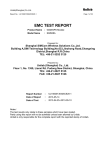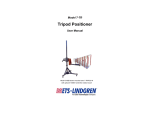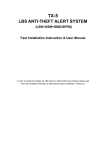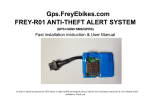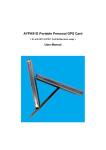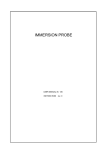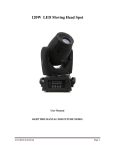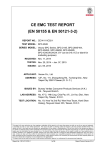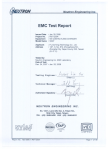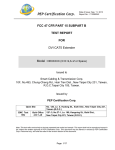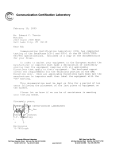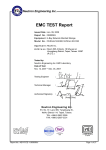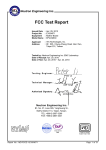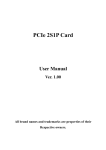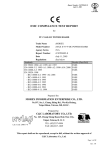Download "user manual"
Transcript
Unilab(Shanghai) Co.,Ltd. Report No. : UL45520150619CE001 Page 1 of 23 EMC TEST REPORT Product Name Model Name : : Lithium-ion Polymer Battery HCP484555NFC-2S1P Prepared for: Shenzhen Honcell Energy Co., Ltd. 612, Bldg. A, Weidonglong Industrial Zone, Meilong Ave.194#, Longhua New District, Shenzhen, 518109, China. TEL: 0755-23731316 FAX: 0755-23731319 Prepared by: Unilab (Shanghai) Co., Ltd. Floor 1, No. 1350, Lianxi Rd. Pudong New District, Shanghai, China TEL: +86-21-5027 5125 FAX: +86-21-5027 5126 Report Number Date of Report Date of Test : : : UL45520150619001 06-26-2015 06-19-2015~06-26-2015 Notes: The test results only relate to these samples which have been tested. Partly using this report will not be admitted unless been allowed by Unilab. Unilab is only responsible for the complete report with the reported stamp of Unilab. 1 Unilab(Shanghai) Co.,Ltd. Report No. : UL45520150619CE001 Page 2 of 23 Applicant: Shenzhen Honcell Energy Co., Ltd. 612, Bldg. A, Weidonglong Industrial Zone, Meilong Ave.194#, Longhua New District, Shenzhen, 518109, China. Manufacturer: Shenzhen Honcell Energy Co., Ltd. 612, Bldg. A, Weidonglong Industrial Zone, Meilong Ave.194#, Longhua New District, Shenzhen, 518109, China. Product Name: Lithium-ion Polymer Battery Brand Name: HC Model Name: HCP484555NFC-2S1P Technical Data: DC:7.4V 1400mAh Date of Receipt: 06-19-2015 Date of Test: 06-19-2015~06-26-2015 Test Standard: EN 55022: 2010+AC:2011 EN 55024: 2010 Test Result: PASS Prepared by : (Technical Engineer: Paul Yang) Reviewed by : (Senior Engineer: Forest Cao) Approved by : (Supervisor Engineer: Eva Wang) 2 Unilab(Shanghai) Co.,Ltd. Report No. : UL45520150619CE001 Page 3 of 23 TABLE OF CONTENTS 1. GENERAL INFORMATION .................................................................................. 4 1.1 EUT DESCRIPTION ................................................................................... 4 1.2 TEST MODE DESCRIPTION ..................................................................... 4 2. TECHNIACL SUMMARY ...................................................................................... 5 2.1 SUMMARY OF STANDARDS AND TEST RESULTS ............................... 5 2.2 TEST UNCERTAINTY................................................................................ 5 2.3 TEST EQUIPMENT LIST ........................................................................... 6 2.4 TEST FACILITY ......................................................................................... 6 2.5 Immunity Performance Criteria ............................................................... 7 2.6 TEST SETUP CONFIGURATION .............................................................. 8 3. RADIATED DISTURBANCE (RE) ........................................................................ 9 3.1 TEST SETUP ............................................................................................. 9 3.2 LIMITS........................................................................................................ 9 3.3 TEST PROCEDURE ................................................................................ 10 3.4 TEST RESULT ......................................................................................... 11 4. ELECTROSTATIC DISCHARGE (ESD) ............................................................. 13 4.1 TEST SPECIFICATION............................................................................ 13 4.2 TEST SETUP ........................................................................................... 13 4.3 TEST PROCEDURE ................................................................................ 13 4.4 RESULTS & PERFORMANCE ................................................................ 14 5. RF ELECTROMAGNETIC FIELD IMMUNITY .................................................... 16 5.1 TEST SPECIFICATION............................................................................ 16 5.2 TEST SETUP ........................................................................................... 16 5.3 TEST PROCEDURE ................................................................................ 16 5.4 RESULTS & PERFORMANCE ................................................................ 17 APPENDIX 1 PHOTOGRAPHS OF TEST SETUP.............................................. 18 APPENDIX 2 PHOTOGRAPHS OF EUT ............................................................ 20 3 Unilab(Shanghai) Co.,Ltd. Report No. : UL45520150619CE001 Page 4 of 23 1. GENERAL INFORMATION 1.1 EUT DESCRIPTION Product Name: Model Name: Technical Data: Lithium-ion Polymer Battery HCP484555NFC-2S1P 7.4V, 1400mAh, Double batteries 1.2 TEST MODE DESCRIPTION Unilab has verified the construction and function in typical operation. All the test modes were carried out with the EUT in normal operation, which was shown in this test report is the worst test mode. Final Test Mode Final Test Mode EMI Discharge Operation EMS Discharge Operation 4 Unilab(Shanghai) Co.,Ltd. Report No. : UL45520150619CE001 Page 5 of 23 2. TECHNIACL SUMMARY 2.1 SUMMARY OF STANDARDS AND TEST RESULTS The EUT have been tested according to the applicable standards as referenced below: EMISSION Test Item Standard Result N/A 1 Conducted disturbance EN 55022:2010+AC:2011 Radiated disturbance EN 55022:2010 Harmonic current emission EN 61000-3-2:2006+A1:2009+A2:2009 N/A Voltage fluctuations & flicker EN 61000-3-3:2008 N/A P IMMUNITY (EN 55024: 2010) Test Item Standard Result Electrostatic discharge (ESD) IEC 61000-4-2 P Radio-frequency electromagnetic field Immunity IEC 61000-4-3 P Electrical fast transients (EFT) IEC 61000-4-4 N/A Surges IEC 61000-4-5 N/A Radio-frequency continuous conducted Immunity IEC 61000-4-6 N/A Power-frequency magnetic fields Immunity IEC 61000-4-8 N/A Voltage dips and interruptions IEC 61000-4-11 N/A Note *: 1: P means pass, F means failure, N/A means not applicable. 2.2 TEST UNCERTAINTY Where relevant, the following test uncertainty levels have been estimated for tests performed on the EUT as specified in CISPR 16-4-2. This uncertainty represents an expanded uncertainty expressed at approximately the 95% confidence level using a coverage factor of k=2. Test item Value (dB) Radiated disturbance 4.2 5 Unilab(Shanghai) Co.,Ltd. Report No. : UL45520150619CE001 Page 6 of 23 2.3 TEST EQUIPMENT LIST 3M Semi-anechoic Chamber - Radiated disturbance Test Equipment 3M Chamber & Accessory Equipment Receiver Manufacturer Model Serial No. Due Date ETS-LINDGREN FACT-3 CT-0000336 11/25/2015 Agilent N9038A MY51210142 11/11/2015 Biconilog Antenna SCHWARZBECK VULB 9160 3316 09/19/2016 Shielding Room No. 2 - ESD Test (IEC 61000-4-2) Equipment Manufacturer Model Serial No. Due Date ESD Simulator EM TEST AG Dito Version 2.31 DM-1132 09/04/2015 3M Full-anechoic Chamber - RF electromagnetic field Immunity Test (IEC 61000-4-3) Equipment Manufacturer Model Serial No. Due Date Power Meter R&S NRVD 101457 11/04/2015 Signal generators R&S SMR20 101440 11/04/2015 Power Amplifier B&K BLWA 056186-01 07/20/2015 VHF/UHF EMS Antenna SCHWARZBECK HL046E 100008 10/15/2015 The measuring equipment utilized to perform the tests documented in this report has been calibrated once a year or in accordance with the manufacturer's recommendations, and has been calibrated by accredited calibration laboratories. 2.4 TEST FACILITY The site and apparatus are constructed in conformance with the requirements of ANSI C63.4, CISPR 16-1-1 and other equivalent standards. The laboratory is compliance with the requirements of the ISO/IEC/EN 17025. 6 Unilab(Shanghai) Co.,Ltd. Report No. : UL45520150619CE001 Page 7 of 23 2.5 Immunity Performance Criteria The manufacturer has the obligation to express the performance criteria in terms which relate to the performance of his specific product when used as intended. The following performance criteria are applicable, and shall only be evaluated when the functions referred to are implemented. Examples of functions defined by the manufacturer to be evaluated during testing include, but are not limited to, the following: – essential operational modes and states; – tests of all peripheral access (hard disks, floppy disks, printers, keyboard, mouse, etc.); – quality of software execution; – quality of data display and transmission; – quality of speech transmission. General Performance Criteria Product Standard EN 55024:2010 CRITERION A During and after the test the EUT shall continue to operate as intended without operator intervention. No degradation of performance or loss of function is allowed below a minimum performance level specified by the manufacturer when the EUT is used as intended. The performance level may be replaced by a permissible loss of performance. If the minimum performance level or the permissible performance loss is not specified by the manufacturer, then either of these may be derived from the product description and documentation, and by what the user may reasonably expect from the EUT if used as intended. After the test, the EUT shall continue to operate as intended without operator intervention. No degradation of performance or loss of function is allowed, after the application of the phenomena below a performance level specified by the manufacturer, when the EUT is used as intended. The performance level may be replaced by a permissible loss of performance. CRITERION B During the test, degradation of performance is allowed. However, no change of operating state or stored data is allowed to persist after the test. If the minimum performance level (or the permissible performance loss) is not specified by the manufacturer, then either of these may be derived from the product description and documentation, and by what the user may reasonably expect from the EUT if used as intended. During and after testing, a temporary loss of function is allowed, provided the function is self-recoverable, or can be restored by the operation of the controls or CRITERION C cycling of the power to the EUT by the user in accordance with the manufacturer’s instructions. Functions, and/or information stored in non-volatile memory, or protected by a battery backup, shall not be lost. Functions, and/or information stored in non-volatile memory, or protected by a battery backup, shall not be lost. 7 Unilab(Shanghai) Co.,Ltd. Report No. : UL45520150619CE001 Page 8 of 23 2.6 TEST SETUP CONFIGURATION See test photographs attached in Appendix 1 for the actual connections between EUT and support equipment. Notes: 1. All the equipment/cables were placed in the worst-case configuration to maximize the emission during the test. 2. Grounding was established in accordance with the manufacturer’s requirements and conditions for the intended use. 8 Unilab(Shanghai) Co.,Ltd. Report No. : UL45520150619CE001 Page 9 of 23 3. RADIATED DISTURBANCE (RE) 3.1 TEST SETUP 30MHz ~ 1GHz: Above 1GHz: 3.2 LIMITS EN Limits for radiated disturbance of Class B ITE Frequency (MHz) Quasi-peak limits at 3m dB(μV/m) 30-230 40 230-1000 47 Frequency (GHz) limit above 1G at 3m dB(μV/m) Average peak 1-3 50 70 3-6 54 74 NOTE: The lower limit shall apply at the transition frequencies. 9 Unilab(Shanghai) Co.,Ltd. Report No. : UL45520150619CE001 Page 10 of 23 3.3 TEST PROCEDURE 30MHz ~ 1GHz: a. The EUT and support equipment were placed on the non-conductive turntable 0.8m above the horizontal metal ground plane at a chamber. The EUT was set 3 meters away from the receiving antenna, which was mounted on an antenna tower. Broadband antenna (Calibrated Bilog Antenna) was used as receiving antenna. b. The frequency range from 30MHz to 1GHz was checked. The RBW of the receiver was set at 120kHz. Set the receiver in Peak detector, Max Hold mode. Record the maximum field strength of all the pre-scan process in the full band when the antenna is varied between 1~4 m in both horizontal and vertical, and the turntable is rotated from 0 to 360 degrees. c. For each frequency whose maximum record was higher or close to limit, measure its QP value: vary the antenna’s height and rotate the turntable from 0 to 360 degrees to find the height and degree where EUT radiated the maximum emission, then set the test frequency receiver to QP Detector and record the maximum value. Above 1GHz: a. The EUT and support equipment were placed on the non-conductive turntable 0.8m above the ground at a chamber. The EUT was set 3 meters away from the receiving antenna, which was mounted on an antenna tower. Horn antenna was used as receiving antenna. b. The frequency range above 1GHz was checked. The RBW of the receiver was set at 1MHz. Set the receiver in Peak detector, Max Hold mode. Record the maximum field strength of all the pre-scan process in the full band when the antenna is 1m and varied in both horizontal and vertical, and the turntable is rotated from 0 to 360 degrees. c. For each frequency whose maximum record was higher or close to limit, measure its Average value: rotate the turntable from 0 to 360 degrees to find the degree where EUT radiated the maximum emission, then set the test frequency receiver to EMI Average Detector and record the maximum value. 10 Unilab(Shanghai) Co.,Ltd. Report No. : UL45520150619CE001 Page 11 of 23 3.4 TEST RESULT 30MHz ~ 1GHz:EN Test mode: Full load and connect network cable 11 Unilab(Shanghai) Co.,Ltd. Report No. : UL45520150619CE001 Page 12 of 23 12 Unilab(Shanghai) Co.,Ltd. Report No. : UL45520150619CE001 Page 13 of 23 4. ELECTROSTATIC DISCHARGE (ESD) 4.1 TEST SPECIFICATION Basic Standard Test Port Discharge Impedance Discharge Mode Discharge Period : : : : : EN 55024 & IEC 61000-4-2 Enclosure port 330 ohm / 150 pF Single Discharge one second between each discharge 4.2 TEST SETUP 4.3 TEST PROCEDURE The test applied a non-conductive surface and a horizontal coupling plane on a wooden table, 0.8 m high, standing on the reference ground plane, which is a 3 m x 4 m metallic sheet with 1.5 mm thickness. This reference ground plane projected beyond the EUT by at least 0.5 m on all sides and the minimum distance between the EUT and all other conductive structure, except the ground plane beneath the EUT, was more than 1.0 m. ESD shall be applied only to those points and surfaces of the EUT which are expected to be touched during usual operation, including user access, as specified in the user manual. The discharges shall be applied in the following: A. Contact discharge (Tests shall be performed at a maximum repetition rate of one discharge per second.): a. Direct discharge: The tip of the discharge electrode should touch the EUT, before the discharge switch was operated. The EUT shall be exposed to at least 200 discharges, 100 each at negative and positive polarity, at a minimum of four test points (a minimum of 50 discharges at each point). One of the test points shall be subjected to at least 50 indirect discharges (contact) to the center of the front edge of the horizontal coupling plane. If no direct contact test points are available, then at least 200 indirect discharges shall be applied in the indirect mode (use of the Vertical Coupling Plane) b. Indirect discharge: b1. Horizontal Coupling Plane (HCP): More than 50 single discharges were applied at the front edge of each HCP opposite the center point of the EUT and 0.1m from vertically the front of the EUT. Discharge to the HCP was made horizontal to the edge of the HCP. 13 Unilab(Shanghai) Co.,Ltd. Report No. : UL45520150619CE001 Page 14 of 23 b2. Vertical Coupling Plane (VCP): More than 50 single discharges were applied to the center of one vertical edge of the coupling plane. The coupling plane, of dimensions 0.5 m x 0.5 m, was placed parallel to, and positioned at a distance of 0. m from the EUT. Discharges were applied to the coupling plane, with this plane in sufficient different positions that all sides of the EUT were completely illuminated. B. Air discharge at slots and apertures, and insulating surfaces: On those parts of the EUT where it is not possible to perform contact discharge testing, the equipment should be investigated to identify user accessible points where breakdown may occur. Such points are tested using the air discharge method. The round discharge tip of the discharge electrode was approached as fast as possible to touch the EUT. After each discharge, the ESD simulator (discharge electrode) was removed from the EUT. The simulator was then re-trigged for a new single discharge and applies more than 10 times on each reselected point. This procedure was repeated until the air discharge completed. 4.4 RESULTS & PERFORMANCE Discharge point: 14 Unilab(Shanghai) Co.,Ltd. Report No. : UL45520150619CE001 Page 15 of 23 EUT : Lithium-ion Polymer Battery Humidity : 51% Mode : Discharge Operation M/N Temperature : HCP484555NFC-2S1P : 22℃ Air discharge (Direct discharge) Test location Test level (±kV) Minimum number of discharge per polarity (each location) 1~61 4,6,8 10 Result (Pursuant to EN55024,Criterion A) PASS Contact discharge (HCP) Test location Test level (±kV) Minimum number of discharge per polarity (each location) Front 2,4 25 Result (Pursuant to EN55024,Criterion A) PASS Rear 2,4 25 PASS Left 2,4 25 PASS Right 2,4 25 PASS Contact discharge (VCP) Test location Test level (±kV) Minimum number of discharge per polarity (each location) Front 2,4 25 Result (Pursuant to EN55024,Criterion A) PASS Rear 2,4 25 PASS Left 2,4 25 PASS Right 2,4 25 PASS Note 1: These points are evaluated before the test. They could be discharged in the process of actual test. 15 Unilab(Shanghai) Co.,Ltd. Report No. : UL45520150619CE001 Page 16 of 23 5. RF ELECTROMAGNETIC FIELD IMMUNITY 5.1 TEST SPECIFICATION Basic Standard Test Port Step Size Modulation Dwell Time Polarization : : : : : : EN 61000-4-3 Enclosure port 1% 1kHz, 80% AM 1 second Horizontal & Vertical 5.2 TEST SETUP 5.3 TEST PROCEDURE a. The EUT and support equipment were placed on the non-conductive table 0.8m above the ground plane at a fully-anechoic chamber. The transmit antenna was located at a distance of 3 meters from the EUT and support equipment. b. The frequency range is swept from 80MHz to 1000MHz, with the signal 80% amplitude modulated with a 1 kHz sine wave. The rate of sweep did not exceed 1.5x 10 -3 decade/s. Where the frequency range is swept incrementally, the step size was 1%. The dwell time at each frequency shall be not less than the time necessary for the EUT to be able to respond. c. The test was performed with the EUT exposed to both vertically and horizontally polarized fields on each side. A CCD camera was put inside the chamber and through its display to monitor the operational situation of the EUT to judge the EUT performance criterion during test. 16 Unilab(Shanghai) Co.,Ltd. Report No. : UL45520150619CE001 Page 17 of 23 5.4 RESULTS & PERFORMANCE EUT : Lithium-ion Polymer Battery Humidity : 53% Mode : Discharge Operation M/N Temperature : HCP484555NFC-2S1P : 23℃ Frequency (MHz) EUT Position Antenna Polarization Field Strength (V/m) Result 80 - 1000 Front Horizontal 3 PASS 80 - 1000 Front Vertical 3 PASS 80 - 1000 Rear Horizontal 3 PASS 80 - 1000 Rear Vertical 3 PASS 80 - 1000 Left Horizontal 3 PASS 80 - 1000 Left Vertical 3 PASS 80 - 1000 Right Horizontal 3 PASS 80 - 1000 Right Vertical 3 PASS 80 - 1000 Floor Horizontal 3 PASS 80 - 1000 Floor Vertical 3 PASS 80 - 1000 Top Horizontal 3 PASS 80 - 1000 Top Vertical 3 PASS 17 Unilab(Shanghai) Co.,Ltd. Report No. : UL45520150619CE001 APPENDIX 1 Page 18 of 23 PHOTOGRAPHS OF TEST SETUP RADIATED DISTURBANCE TEST SETUP-30M~1G ESD TEST SETUP 18 Unilab(Shanghai) Co.,Ltd. Report No. : UL45520150619CE001 Page 19 of 23 RADIO-FREQUENCY ELECTROMAGNETIC FIELD IMMUNITY TEST SETUP 19 Unilab(Shanghai) Co.,Ltd. Report No. : UL45520150619CE001 APPENDIX 2 Page 20 of 23 PHOTOGRAPHS OF EUT View of EUT-1 View of EUT-2 1 2 2 1 20 Unilab(Shanghai) Co.,Ltd. Report No. : UL45520150619CE001 Page 21 of 23 View of EUT-3 View of EUT-4 21 Unilab(Shanghai) Co.,Ltd. Report No. : UL45520150619CE001 Page 22 of 23 View of EUT-5 1 2 2 1 View of EUT-6 22 Unilab(Shanghai) Co.,Ltd. Report No. : UL45520150619CE001 Page 23 of 23 View of EUT-7 ----End of the report---- 23























